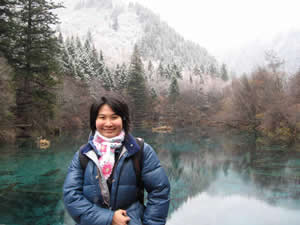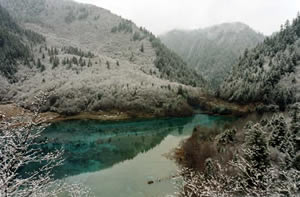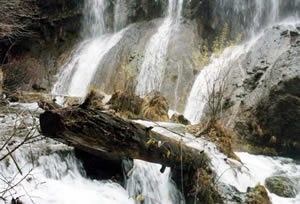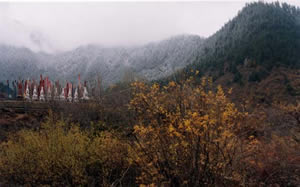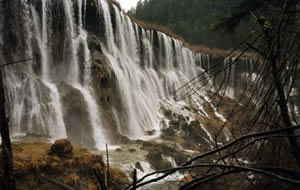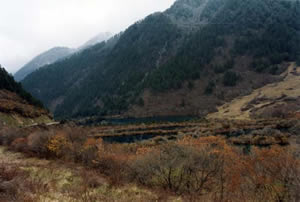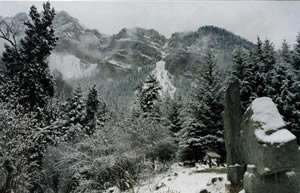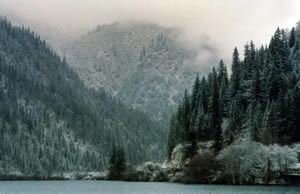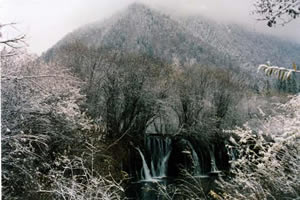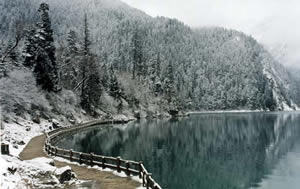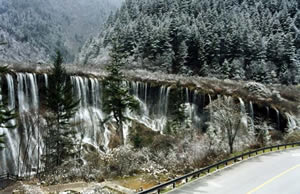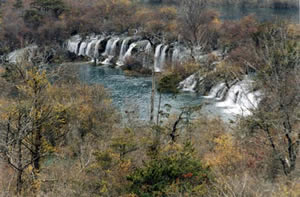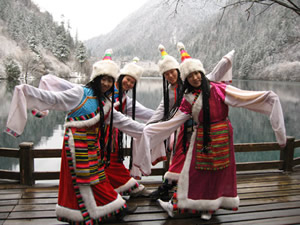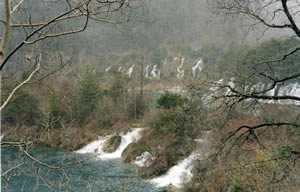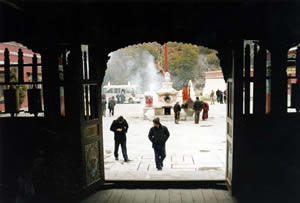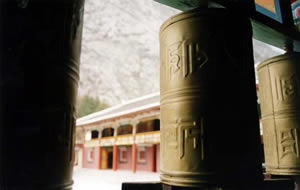| Observing
the Giant Where Its Heart Beats
And I was among the lucky, that could watch her from where her heart beats. This series of writings are notes from my experiences here in China. I could by no means truthfully depict her, for the truth belonged only to impossibility. I could only give you what has come to my mind as I encountered her. Part 01 - Heaven Whispered Poetry in Jiuzhaigou Valley I should not describe Jiuzhaigou by words. I can only say that it looked surreal to me. When the 720 square kilometers national park opened its door to me in the second week of November last year, three seasons danced before my eyes. Some areas were green, as if summer kisses were still fresh and warm. Some areas were bright yellow and red. Autumn was on its final footsteps, but behind its lyrical mountains, lakes were already frozen in silent blue.
Legend said that a pair of god and goddess was in love. The god intended to present a mirror as a love gift for his beautiful lover. However, an envious god grabbed the mirror before she received it and smashed it on earth. The pieces of broken mirror became Jiuzhaigou Valley’s 114 lakes, 17 groups of waterfalls, 11 torrents and 5 calcareous tufa shoals.
Like other beautiful places on earth, some indigenous people have lived there for generations before it was "discovered" by those who owned history, in this case the Chinese government. Jiuzhaigou experienced some heavy logging activities before the Chinese authorities declared it as a protected natural site.
The government was able to persuade the indigenous people to let their native land to be turned into a national park. They could still live there and earned profit from tourism, as long as they followed some procedures to protect the park. They sold jewelry, rented a baby goat and traditional dresses to take pictures with, and performed folk arts for tourists. Worldwide Fund was also promoting sustainable development in the area. The indigenous people were taught to grow marketable mushrooms and to maintain good sanitation.
Bonbo Buddhism was embraced by most of the locals. It was a branch from Tibetan Buddhism that incorporated the indigenous Bonbo religion into Buddhism. Within the park, tourists could find at least two Buddhist temples. Nine white pagodas that each stood on a lotus base could be seen from afar with wavering banners for those who sought enlightenment. On the banners, Buddhist scripture was printed. Cylindrical tins marked the Tibetan Buddhist influence in the area. Visitors would roll the cylinders around the worship place three times and whisper their wish. A living Buddha, known as Lamma, resided in one of the temples. Anyone could visit him in his dark aromatized room to get a sprinkle of blessing.
Conflict of interests remained steep in Sichuan Province, where Jiuzhaigou was located. The area was blessed with forests that hosted not only rare species like giant panda, religious sacred places, and timber. It had the potential to draw tourists and to generate energy from its all-year flowing water. The local government would love to have a massive commercial tourism that could finance the development of the deprived province, but conservationists suggested a more managed small-scale tourism, so the nature could still be kept intact. Timber companies would like to log its dense forests. Some locals got their money by hunting endangered species. Dam projects were also lining up to be approved to electrify the raising China with 1.3 billion of population. I retrieved this insight about conservation issues when interviewing a WWF field officer for their initiatives at Minshan mountain range that also covered Jiuzhaigou.
Struggle to balance between development and environmental protection was getting hotter in many developing countries like China. Because China had to narrow the gap between the rich and the poor due to her current economic strategy, commercial tourism in a remote province like Sichuan was seen as a huge potential to reduce poverty. The gigantic China also needed a lot of energy. However, creating dams to generate power meant to flood forests containing valuable biodiversity. Which interest should be put first? The giant had to deal with this puzzle everyday. Meanwhile, Europe and America, who were once beacons of environmental protection, today had demolished most of its old-grown forests for industrialization.
The people that I talked to in Jiuzhaigou, including the women who rented traditional dresses and the tour guide, claimed that life was better in Jiuzhaigou after tourism flourished. This was also the general opinion in China. Some migrant workers from Sichuan that I met on the train in a different trip told me that although life was difficult in Sichuan, they were thankful that after the Reform and Opening Up era in China they could travel easily and find better jobs in other provinces.
As always, life presented more questions than answers. As for China, the questions stacked mountain-high. How should she take advantage of her gorgeous landscape without sacrificing the environment? How could she alleviate poverty without going into the same process of environmental destruction that the West experienced? How could she produce enough energy without huge dam projects? She has prevailed for five thousand years of human history. She surely could not afford to disappoint her ancestors.
Travel Tips: I explored Jiuzhaigou in two days. It was not really enough because I was using the zero-emission shuttle bus to go from one point of interest to the next. I wished I could have wandered around on foot. If you wish to hike, plan to stay for three days. I reached Jiuzhaigou by flying from Beijing to
Chengdu, the capital of Sichuan Province. With a rented car, it
took 10 hours to drive from Chengdu to Jiuzhaigou. You may also
choose to arrive in Jiuzhaigou’s airport, but it could be
a much more expensive route. The car ride was very pleasant, because
Mingshan mountain range would offered you breathtaking scenery.
Other than Jiuzhaigou, Sichuan province drew the attention of
tourists worldwide for its Giant Panda Research Center and Buddhist
holy mountains Leshan and Emeishan.
|
